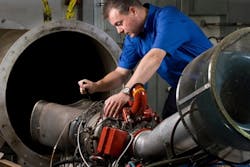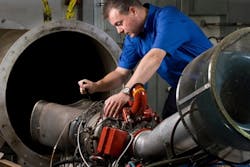Growing number of aerospace applications require effective data acquisition technologies
Aerospace engineers are adopting modern data acquisition (DAQ) hardware and software to meet a wide variety of commercial, military, and government test and measurement, engineering, operational, condition monitoring, and maintenance needs.
NASA crash test harvests valuable data with DTS equipment
NASA researchers at Langley Research Center in Hampton, Va., for the third time in less than two months, intentionally sent an aircraft equipped with data acquisition equipment plummeting to the ground. The latest drop test, devised to simulate a severe but survivable crash, involved a Cessna 172 plunging 100 feet at 55 miles per hour. NASA conducted three Cessna tests, each simulating different, but common, crash conditions: nose down on concrete, nose down into soil, and, lastly, tail down into soil. NASA researchers equipped each plane with five emergency locator transmitters (ELTs), two crash test dummies, 40 cameras, and test equipment from Diversified Technical Systems (DTS), including 64-channels of TDAS data recorders, a Smart Battery, and TDAS Distributor. Researchers will examine all the data and images from the crash test, both on the plane and around the test site, to learn how crashes affect the ELTs with the ultimate goal of improving ELT performance on all aircraft. NASA uses DTS miniature on-board data acquisition systems at four different facilities for a variety of dynamic tests, including heavy payload and flight testing, aerobrake testing, and on the Low Density Supersonic Decelerator, officials say.
Turbomeca selects Gantner Instruments for test bench instrumentation
Officials overseeing the turbine testing facilities at Turbomeca in Fareham, England, needed a data logging system. They found their solution at Gantner Instruments, with offices in San Diego. Turbomeca is a member of the Safran Group, which specializes in the development, production, sale, and support of gas turbines for helicopters. Company engineers test all units to ensure they meet important specifications, such as power input, acceleration time, and other mechanical and thermal properties. Key Features include: speed, accuracy, high resolution, electrical isolation, built-in signal conditioning, ruggedness, synchronous logging of all channels using external reference time, and modularity to enable the system to be used during research and development as well as production phases.
Cessna builds compact in-flight data acquisition system with PowerDNA Cube
Cessna engineers have designed, built, and tested their new Micro-Pak in-flight data acquisition system in record time with help from a PowerDNA Cube and associated I/O modules from United Electronic Industries (UEI) in Walpole, Mass. The system is initially being used to collect in-flight, near-real-time data from the new Model 162 SkyCatcher single-engine, piston-powered monoplane. The Cessna Micro-Pak high-density, configurable system is designed to meet the data collection requirements for many aircraft types currently being developed at Cessna. The Micro-Pak unit is separate from the aircraft, portable, and doesn’t require modifications to the aircraft itself; it can be configured, calibrated, and tested as an off-line task, independent of the aircraft in which it will be installed. Cessna’s new Cessna Micro-Pak in-flight DAQ system employs UEI’s PowerDNA Cube host computer in a six-layer configuration able to accommodate any of more than 60 different types of UEI PowerDNA I/O boards that interface with various types of sensors, officials explain. Cessna uses sensors to measure various temperatures in the engine, aircraft, and environment, as well as pressures such as altitude, manifold pressure, engine oil, and more. The Cube used in the Micro-Pak on-board DAQ system is outfitted with various UEI I/O boards, including the DNA-AI-207 Analog Input Board, DNA-CT-601 Counter/Timer Input Board, and DNA-ARINC-429-566 ARINC Communications Interface Board.
VivaAerobus selects aircraft condition monitoring solution from Teledyne Controls
Engineers at VivaAerobus, a low-cost carrier in Monterrey, Mexico, have elected to equip the airline’s new fleet of 52 Airbus A320 aircraft with a series of reliable data acquisition, aircraft condition monitoring, and wireless data transfer solutions from Teledyne Controls in El Segundo, Calif. The Mexico-based airline has opted for Teledyne’s Flight Data Interface Management Unit (FDIMU) for data acquisition and Wireless GroundLink Comm+ flexible communication solution to support multiple functions both now and in the future. The new system will meet the airline’s current need for downloading Quick Access Recording (QAR) and Aircraft Condition Monitoring System (ACMS) data, and it can also meet the airline’s future requirements, including the full integration and connectivity of tablet devices as electronic flight bags (EFBs) for flight crews, officials say. Teledyne Controls’ FDIMU performs mandatory data acquisition that provides data to the Black Box Flight Recorder, along with real-time engine and aircraft condition and health monitoring.
Tinker AFB achieves design goals for new engine test cell
Officials at the new Pacer Comet 4 (PC4) jet engine test facility recently at Tinker Air Force Base in Oklahoma sought data acquisition equipment to assist with high-performance testing of a wide range of gas turbine engines deployed by the U.S. Air Force. They found their solution at United Electronics Industries (UEI) in Walpole, Mass. By taking advantage of recent developments in DAQ hardware/software technology, communication system design, and new test cell operating concepts, the PC4 achieves an efficient, flexible, and configurable facility that can meet the testing requirements for all jet engine types currently serviced at Tinker AFB, according to a spokesperson. The Test Cell Chamber is equipped with two network video cameras and an intercom system for increased safety of personnel and immediate detection of faults or fuel leaks. Video, voice, and test information are linked via Ethernet with all other test cells and facility offices for data sharing and greater efficiency. Test data for all engine types is stored in the Engine Health Management Repository Center data base, which provides baseline performance data for each engine type and also enhances security, safety, and cost effectiveness. In addition to the UEI on-frame Data Acquisition/Control System, the Test Facility contains sensors and related equipment to measure vibration, thrust, load, fuel flow, air flow, rotary and linear position, noise, and other variables. All data collected from remote monitoring equipment is transmitted to the Data Display/ Control Computer via Ethernet. The engine of the DAQ system is a PPC8 PowerDNA Cube with a PowerPC CPU, SD card slot, DB-9 Serial Port, SD Card slot, indicating LEDs, and an Ethernet interface plus 6 slots for I/O boards that interface with sensors. The Cube used in the on-frame DAQ system contains the following UEI I/O boards: DNA-AI-225 Thermocouple Analog Input Board, NA-AI-207 General Purpose Analog Input Board, DNA-DIO-401 Digital Input Board, DNA-DIO-402 Digital Output Board, DNA-PC-902 Power Conversion Board, DNA-STP-AI-U Screw Terminal Panel, and DNA-STP-37 Screw Terminal Panels. The Pacer Comet 4 represents a major step forward in Test Cell Design, UEI officials affirm, and is expected to set the standard for efficient, high-performance jet engine testing for years to come.






